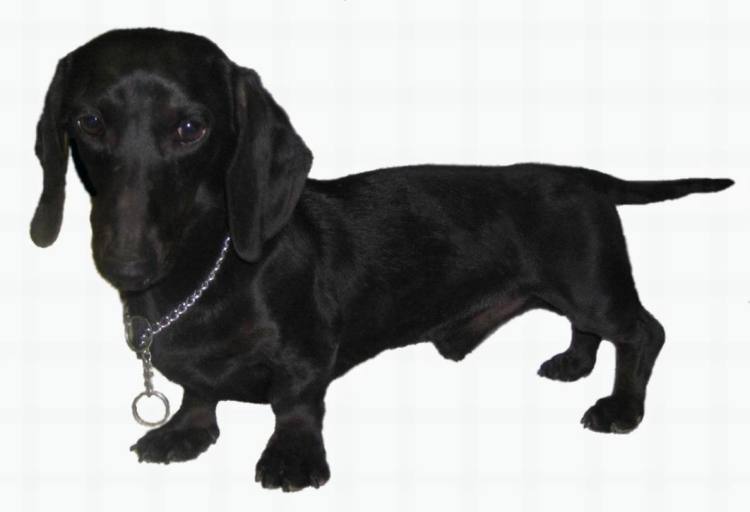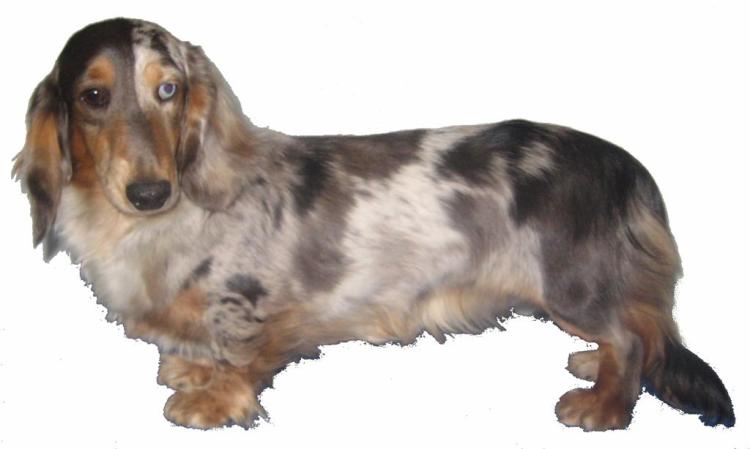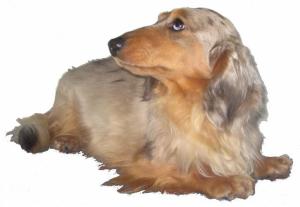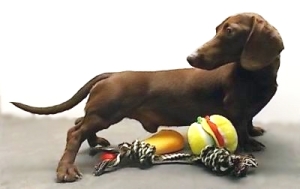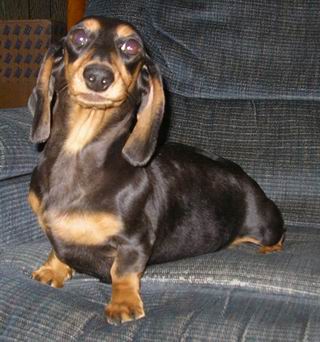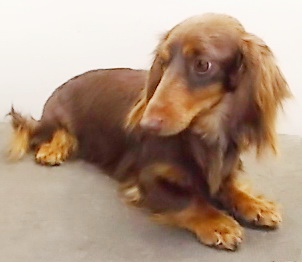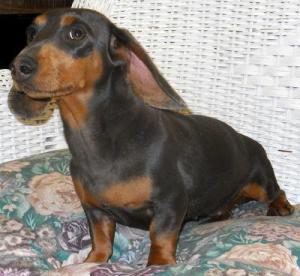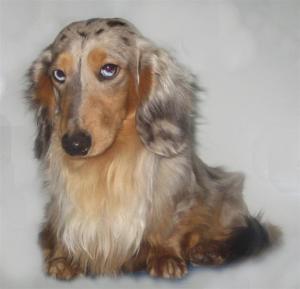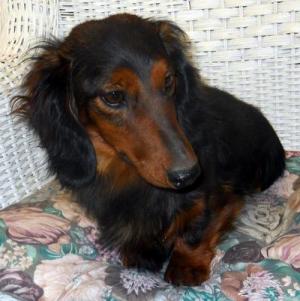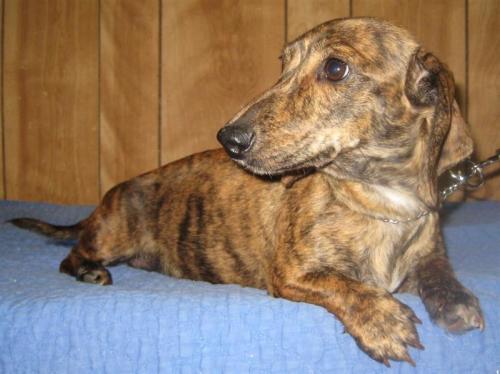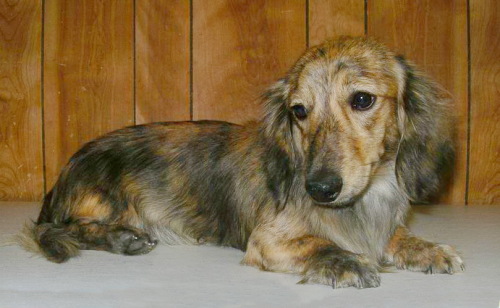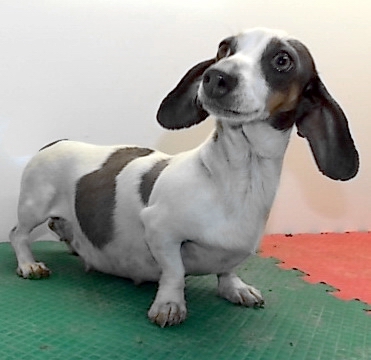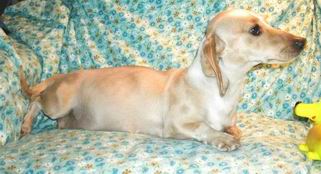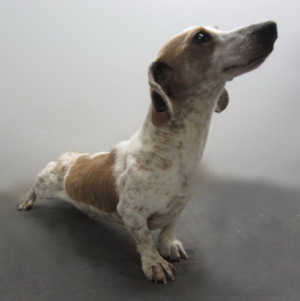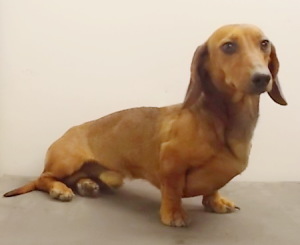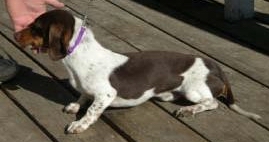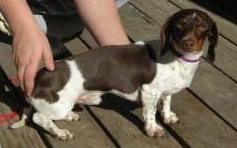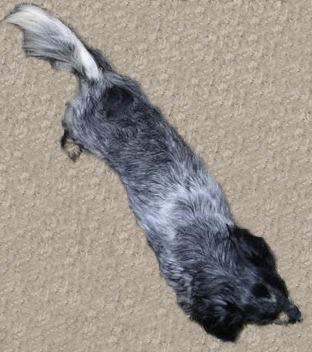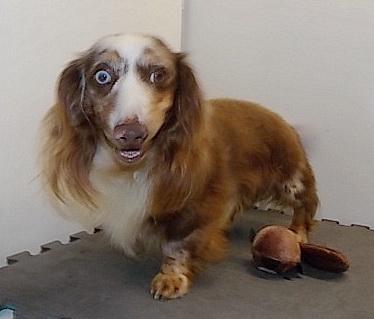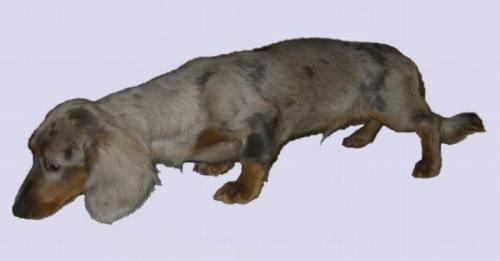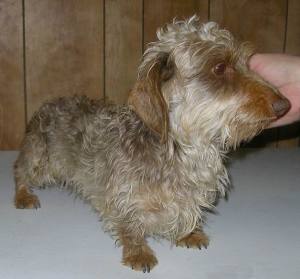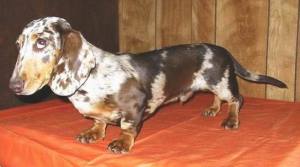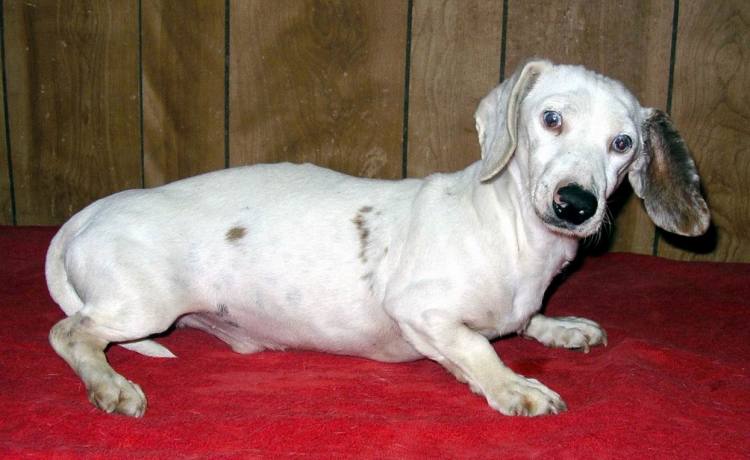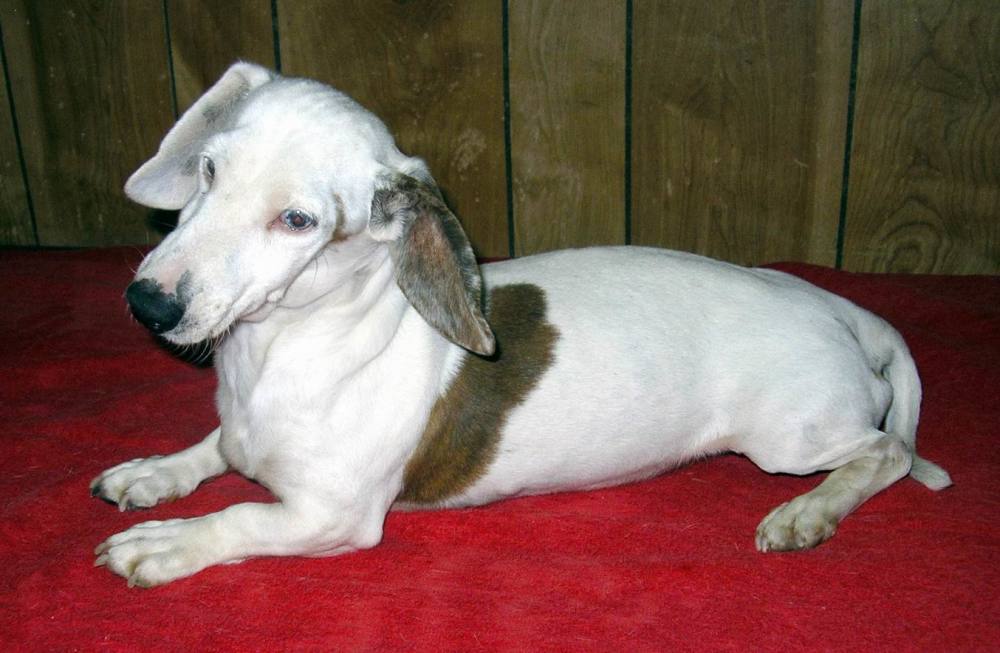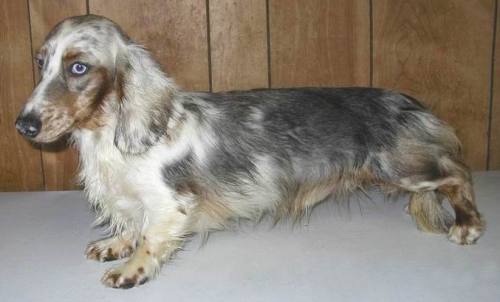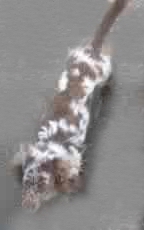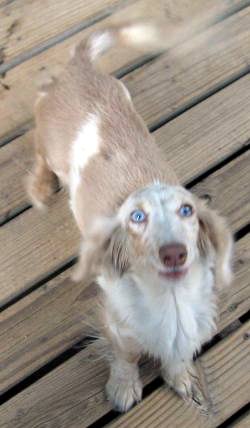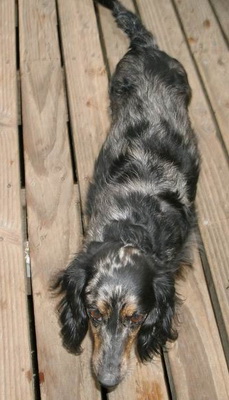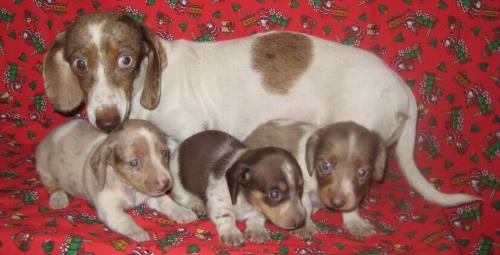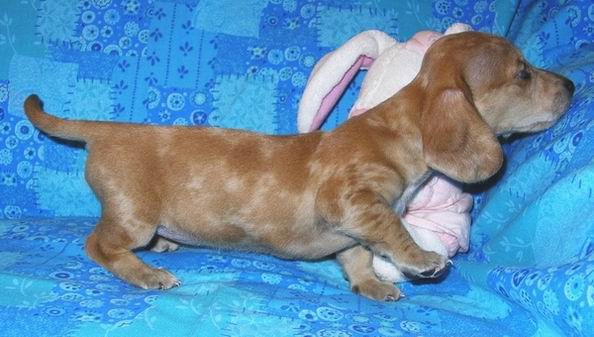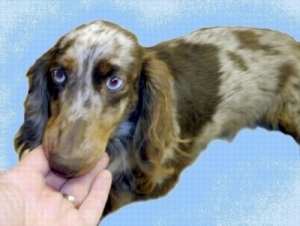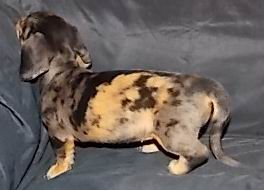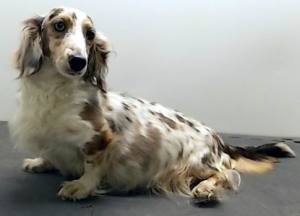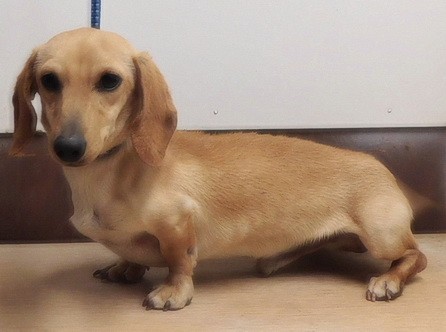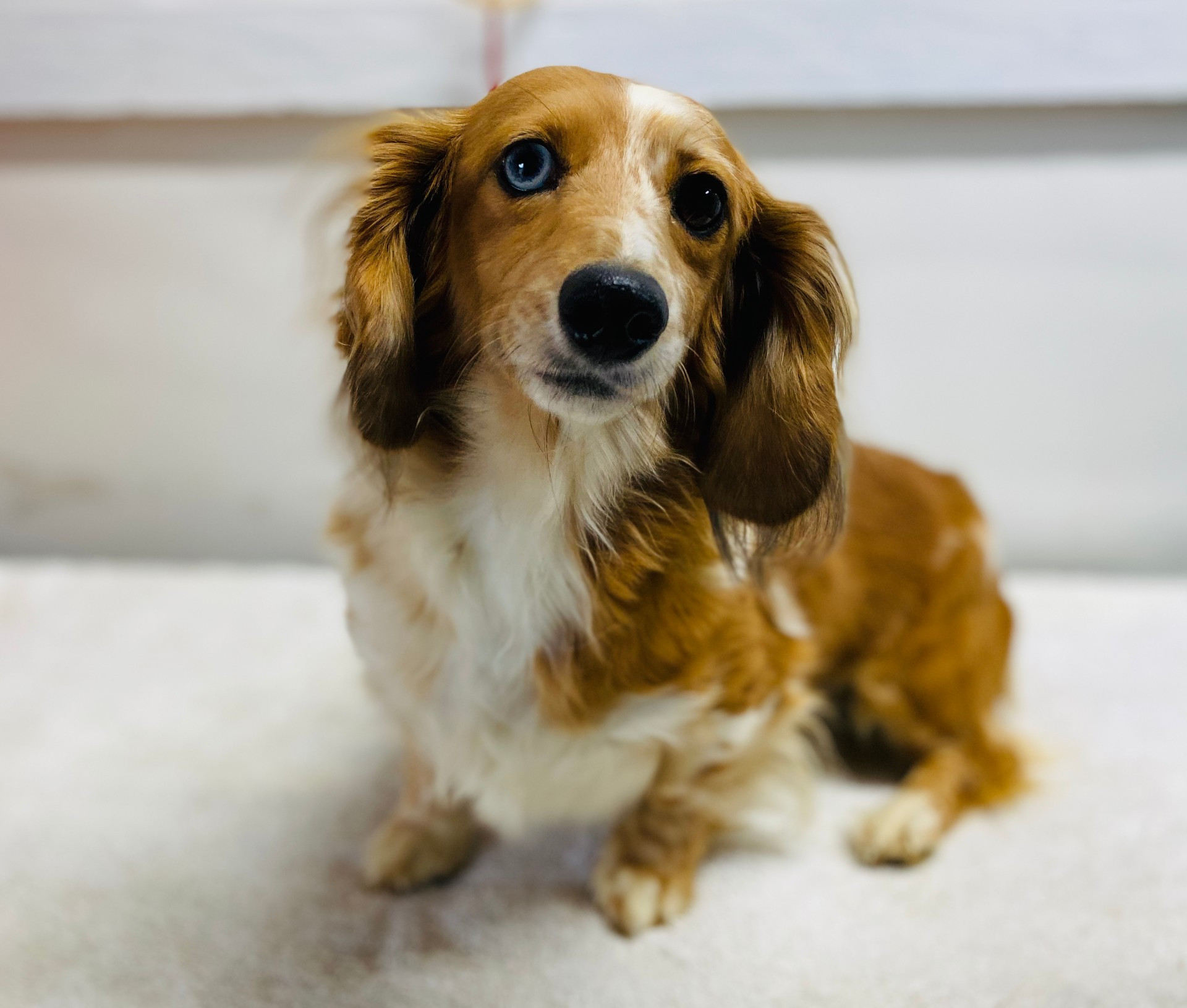COATS, COLORS & PATTERNS
in the
AKC BREED STANDARD
for the
DACHSHUND
with photos of actual Flickennel Dachshunds to illustrate the different coats, colors and patterns described in the Breed Standard (scroll down below the large text area to see photos)
General Appearance—Low to ground, long in body and short of leg with robust muscular development, the skin is elastic and pliable without excessive wrinkling. Appearing neither crippled, awkward, nor cramped in his capacity for movement, the Dachshund is well-balanced with bold and confident head carriage and intelligent, alert facial expression. His hunting spirit, good nose, loud tongue and distinctive build make him well-suited for below-ground
work and for beating the bush. His keen nose gives him an advantage over most other breeds for trailing.
Note—Inasmuch as the Dachshund is a hunting dog, scars from honorable wounds shall not be considered a fault.
Size, Proportion, Substance—Bred and shown in two sizes, standard and miniature, miniatures are not a separate classification but compete in a class division for "11 pounds and under at 12 months of age and older."
Weight of the standard size is usually between 16 and 32 pounds.
Head—Viewed from above or from the side, the head tapers uniformly to the tip of the nose. The eyes are of medium size, almond-shaped and dark-rimmed, with an energetic, pleasant expression; not piercing; very dark in color. The bridge bones over the eyes are strongly prominent. Wall eyes, except in the case of dappled dogs, are a serious fault. The ears are set near the top of the head, not too far forward, of moderate length, rounded, not narrow, pointed, or folded. Their carriage, when animated, is with the forward edge just touching the cheek so that the ears frame the face. The skull is slightly arched, neither too broad nor too narrow, and slopes gradually with little perceptible stop into the
finely formed, slightly arched muzzle. Black is the preferred color of the nose. Lips are tightly stretched, well covering the lower jaw. Nostrils well open. Jaws opening wide and hinged well back of the eyes, with strongly developed bones and teeth.
Teeth—Powerful canine teeth; teeth fit closely together in a scissors bite. An even bite is a minor fault. Any other deviation is a serious fault.
Neck—Long, muscular, clean-cut, without dewlap, slightly arched in the nape, flowing gracefully into the shoulders.
Trunk—The trunk is long and fully muscled. When viewed in profile, the back lies in the straightest possible line between the withers and the short very slightly arched loin. A body that hangs loosely between the shoulders is a serious fault. Abdomen—Slightly drawn up.
Forequarters—For effective underground work, the front must be strong, deep, long and cleanly muscled. Forequarters in detail: Chest—The breastbone is strongly prominent in front so that on either side a depression or dimple appears. When viewed from the front, the thorax appears oval and extends downward to the mid-point of the forearm. The enclosing structure of well-sprung ribs appears full and oval to allow, by its ample capacity, complete development of heart and lungs. The keel merges gradually into the line of the abdomen and extends well beyond the front legs. Viewed in profile, the lowest point of the breast line is covered by the front leg. Shoulder Blades— Long, broad, well-laid back and firmly placed upon the fully developed thorax, closely fitted at the withers, furnished with hard yet pliable muscles. Upper Arm—Ideally the same length as the shoulder blade and at right angles to the latter, strong of bone and hard of muscle, lying close to the ribs, with elbows close to the body, yet capable of free movement. Forearm—Short; supplied with hard yet pliable muscles on the front and outside, with tightly stretched tendons on the inside and at the back, slightly curved inwards. The joints between the forearms and the feet (wrists) are closer together than the shoulder joints, so that the front does not appear absolutely straight. Knuckling over is a disqualifying fault. Feet—Front paws are full, tight, compact, with well-arched toes and tough, thick pads. They may be equally inclined a trifle outward. There are five toes, four in use, close together with a pronounced arch and strong, short nails. Front dewclaws may be removed.
Hindquarters—Strong and cleanly muscled. The pelvis, the thigh, the second thigh, and the metatarsus are ideally the same length and form a series of right angles. From the rear, the thighs are strong and powerful. The legs turn neither in nor out. Metatarsus—Short and strong, perpendicular to the second thigh bone. When viewed from behind, they are upright and parallel. Feet—Hind Paws—Smaller than the front paws with four compactly closed and arched toes with tough, thick pads. The entire foot points straight ahead and is balanced equally on the ball and not merely on the toes. Rear dewclaws should be removed. Croup—Long, rounded and full, sinking slightly toward the tail. Tail—Set in continuation of the spine, extending without kinks, twists, or pronounced curvature, and not carried too gaily. Gait—Fluid and smooth. Forelegs reach well forward, without much lift, in unison with the driving action of hind legs. The correct shoulder assembly and well-fitted elbows allow the long, free stride in front. Viewed from the front, the legs do not move in exact parallel planes, but incline slightly inward to compensate for shortness of leg and width of chest. Hind legs drive on a line with the forelegs, with hocks (metatarsus) turning neither in nor out. The propulsion of the hind leg depends on the dog's ability to carry the hind leg to complete extension. Viewed in profile, the forward reach of the hind leg equals the rear extension. The thrust of correct movement is seen when the rear pads are clearly exposed during rear extension. Feet must travel parallel to the line of motion with no tendency to swing out, cross over, or interfere with each other. Short, choppy movement, rolling or high-stepping gait, close or overly wide coming or going are incorrect. The Dachshund must have agility, freedom of movement, and endurance to do the work for which he was developed.
Temperament—The Dachshund is clever, lively and courageous to the point of rashness, persevering in above and below ground work, with all the senses well-developed. Any display of shyness is a serious fault.
SPECIAL CHARACTERISTICS OF THE THREE COAT VARIETIES
The Dachshund is bred with three varieties of coat: (1) Smooth; (2) Wirehaired; (3) Longhaired, and is shown in two sizes: standard and miniature. All three varieties and both sizes must conform to the characteristics already specified. The following features are applicable for each variety.
Smooth Dachshund—Coat—Short, smooth and shining. Should be neither too long nor too thick. Ears not leathery.
Tail—Gradually tapered to a point. Well but not too richly haired. Long sleek bristles on the underside are considered a patch of strong-growing hair, not a fault. A brush tail is a fault, as is also a partly or wholly hairless tail. Color of Hair—Although base color is immaterial, certain patterns and basic colors predominate. One-colored Dachshunds include red (with or without a shading of interspersed dark hairs or sable) and cream. A small amount of white on the chest is acceptable, but not desirable. Nose and nails—black.
Two-colored Dachshunds include black, chocolate, wild boar, gray (blue) and fawn (Isabella), each with tan markings over the eyes, on the sides of the jaw and underlip, on the inner edge of the ear, front, breast, inside and behind the front legs, on the paws and around the anus, and from there to about one-third to one-half of the length of the tail on the underside. Undue prominence or extreme lightness of tan markings is undesirable. A small amount of white on the chest is acceptable but not desirable. Nose and nails—in the case of black dogs, black; for chocolate, and all other colors, dark brown, but self-colored is acceptable.
Dappled Dachshunds—The "single" dapple pattern is expressed as lighter-colored areas contrasting with the darker base color, which may be any acceptable color. Neither the light nor the dark color should predominate. Nose and nails are the same as for one and two-colored Dachshunds. Partial or wholly blue (wall) eyes are as acceptable as dark eyes. A large area of white on the chest of a dapple is permissible.
A "double" dapple is one in which varying amounts of white coloring occur over the body in addition to the dapple pattern [specifically when both parents were dapple; not all whitened dapples are double dapples! - our note]. Nose and nails: as for one and two-color Dachshunds; partial or wholly self-colored is permissible.
Brindle is a pattern (as opposed to a color) in which black or dark stripes occur over the entire body although in some specimens the pattern may be visible only in the tan points.
Sable is a pattern which was not mentioned in detail in the Standard, so I will describe it here: The sable pattern is only observed on the longhaired red, and is a bi-colored hair pattern (wild boar is 'banded' with three or four colors, appearing only on smooth and wirehair). The tips of the hairs on the body only, (not the tan points of the face, legs etc.) are black while the rest of the hair shaft is red. At a glance the dog may look like a black/tan, but if the hair is parted, it is red next to the body. Since black is NOT present on blue, chocolate or isabella, a dog advertised as a sable in one of those colors is misrepresented. Many 'shaded reds' are also incorrectly called 'sable,' but typically only have black on ears, 'saddle' or dorsal stripe, and tail, and their hair is not bi-colored on each hair shaft. To visibly display the various coats, colors and patterns in dachshunds, photographic examples of our Flickennel Dachshunds are shown below the rest of the text of the AKC Breed Standard.
Wirehaired Dachshund—Coat—With the exception of jaw, eyebrows, and ears, the whole body is covered with a uniform tight, short, thick, rough, hard, outer coat but with finer, somewhat softer, shorter hairs (undercoat) everywhere distributed between the coarser hairs. The absence of an undercoat is a fault. The distinctive facial furnishings include a beard and eyebrows. On the ears the hair is shorter than on the body, almost smooth. The general arrangement of the hair is such that the wirehaired Dachshund, when viewed from a distance, resembles the smooth. Any sort of soft hair in the outer coat, wherever found on the body, especially on the top of the
head, is a fault. The same is true of long, curly, or wavy hair, or hair that sticks out irregularly in all directions. Tail—Robust, thickly haired, gradually tapering to a point. A flag tail is a fault. Color of hair—While the most common colors are wild boar, black and tan, and various shades of red, all colors are admissible. A small amount of white on the chest, although acceptable, is not desirable. Nose and nails—same as for the smooth variety.
Longhaired Dachshund—Coat—The sleek, glistening, often slightly wavy hair is longer under the neck and on the forechest, the underside of the body, the ears, and behind the legs. The coat gives the dog an elegant appearance. Short hair on the ear is not desirable. Too profuse a coat which masks type, equally long hair over the whole body, a curly coat, or a pronounced parting on the back are faults. Tail—Carried gracefully in prolongation of the spine; the hair attains its greatest length here and forms a veritable flag. Color of Hair—Same as for the smooth Dachshund. Nose and nails—same as for the smooth.
The foregoing description is that of the ideal Dachshund. Any deviation from the above dog must be penalized to the extent of the deviation, keeping in mind the importance of the contribution of the various features toward the basic original purpose of the breed.
DISQUALIFICATION: Knuckling over of the front legs. (Photo from the Dachshund Club of America website.)
Approved April 7, 1992
Effective May 27, 1992
Excerpted from: The Complete Dog Book, 19th Edition, Revised, Official Publication of The American Kennel Club, Wiley Publishing, Inc., New York, NY, copyright 1998, 1992, 1979, 1975, 1968, 1956, 1954, 1951, 1947, 1942, 1941 by the American Kennel Club; from pages 162 to 165.
OFFICIAL AMERICAN KENNEL CLUB (AKC)
STANDARD FOR THE DACHSHUND
Bosco: smooth coat, chocolate, solid-color.
Snookie: wirehair, red, brindle.
Cash: longhair, black & tan, reverse-dapple
PHOTO GALLERY OF FLICKENNEL DACHSHUNDS
(past & present)
EXHIBITING THE COATS, COLORS AND PATTERNS OF THE BREED
There are over 500 possible combinations, including 2 recognized sizes & 2 unrecognized sizes! COATS: Smooth (SM), longhair (LH) & wirehair (WH) are displayed in each COLOR group, because they can look quite different from one dog to another. The left column is the RED SERIES, center column is the BLACK SERIES, right column is the CHOCOLATE SERIES. The PATTERNS are shown below the COLORS.
These are all dogs we have now, or have had in the past, representing their specific COAT, COLOR and/or PATTERN, so that the AKC BREED STANDARD descriptions above make more sense. This variety within our gene-pool is also why we can 'build' a pup for you with almost any combination of coat, color and pattern you specify, if we wait long enough for all the genetic particulars to come together at the same time. May we build one for you?!
Chanel SM
Elmer SM
THE THREE BASE COLORS:
RED (one-colored - no tan points) BLACK & TAN (two-colored) CHOCOLATE & TAN (two- colored)
Carrie SM
Big Red LH
Ruby WH
Miracle LH
Lacy WH
Fudge LH
Captain Chenille soft WH.
.
.
.
Red dachshunds have a black nose & toenails (above). A 'liver-nosed' or 'chocolate-based' red with brown or red toenails (below) carries one gene for chocolate, usually from a chocolate parent. Red coats vary from pale cream to deep mahogany, with or without black overlays or trim on ears, back or tail.
SOLID BLACK, NO TAN
Ringo SM
SOLID CHOCOLATE, NO TAN
Bosco SM
DILUTES OF THE THREE BASIC COLORS ABOVE:
ENGLISH CREAM, AMERICAN CREAM & BLUE & TAN ISABELLA/FAWN & TAN
WHEATEN (WIREHAIRS ONLY).
Chocolate, isabella and blue dachshunds in any pattern (brindle, dapple, piebald) will NEVER have BLACK anywhere on them - hair, nose or toenails. If you find black on a dog that looks like one of those colors, it is NOT that color, but is red, cream, wildboar or black in some form.. For instance, Cash looks rather like an isabella dapple, but he's actually a black & tan reverse-dapple; the darkest color on any dapple is its base-color, however much or little there is, which on Cash is black.
Red dachshunds may also have varying amounts of black accents or overlay on ears, shoulders, back and tail, or dapple spots, which may fade away as the dog ages, or stay during its life. Red pups also usually grow either lighter or darker than they were at birth! They're the only color series that change as they age, and red includes all the different creams, described below. Tan 'points' are also considered 'red' in the genetic language. 'Tan' and 'brown' are not actual dachshund color designations; red and chocolate are!
Bullet LH
Cleopatra LH English cream
Fawn LH
Aspen SM
American cream
Blumenau SM
Viva SM
Marilyn LH American cream
Cash LH
Cash LH
There's no such thing as "too much Cash" at Flickennel! He's our King of the Kennel!
We have not had any blue or isabella wirehairs - YET! Give us time! We do have a wheaten wire (parents are from both English cream and wheaten stock). Tiny Einy (it rhymes) arrived late January, 2013, from our East Coast branch in upstate New York - our first "cream of wheat" wirehair! He also carries piebald! If bred to the right dilute & pie females, we could get something really nice... He also has a VERY SWEET personality!
Janet bought a new piebald wirehair male in 2015. Look for pups from Justin, who is a red faux-dilute (blush) dapple piebald, so his pups should also be or carry dilute.
Goldilocks WH
wheaten
SABLE is only observed on a longhaired red or cream, and is a bicolored-hair pattern. The tips of the hairs on the body only, not the tan points of the face, legs etc., are black while the rest of the hair shaft is red. At first glance, the dog may look like a black & tan but if you part the hair, it is red next to the body. Most sables show a pointed 'widow's peak' pattern above their eyes, as well as full-circle tan/red around the eyes, as on Rowdy and Heidi, but some have red heads and black-looking bodies - such as Macy and Mason (Macy's son), who also have the 'widow's peak' and full tan circles around their eyes. Those traits are what we really look for to define a truly sable puppy, which a mere "shaded red" won't have, but many breeders don't know the difference - we do.
Macy LH
Macy LH
Macy LH
Rowdy LH adult
Heidi LH
BRINDLE: a pattern of tiger-stripes most visible on reds & creams, but which can affect every color and pattern. On red, cream and black & tan, the stripes are black, showing on the red, cream or tan portions of the dog, as well as its nails, which may also be striped and a pretty good indicator on a dog we're not sure is brindle - some dapples look striped. On all other colors, the stripes are the same as the base color (blue, isabella, chocolate) and visible only on the tan points. We have one notable exception: Reese's Pieces, a LH English cream brindle with chocolate stripes! And because he's carrying chocolate, his nose and nails are pinkish-brown, not the normal black of a red-series dachshund. His faint chocolate stripes don't show as much now under his full adult coat as they did when he was a pup, but they're there - the nose knows!
Tigger SM
Twix LH chocolate-based English cream brindle
Tigger SM
Stripe WH cream brindle
Rufus LH red brindle
Smoky LH English cream brindle
Brindle SM
Snookie WH red brindle
RED/CREAM BRINDLE BLACK & TAN BRINDLE CHOCOLATE BRINDLE
Garland LH
We've never had a chocolate & tan brindle, pup or adult! The closest we have is Reece's Pieces, who resembled Twix (below) when he was a little puppy.
Reece's Pieces ML
It's hard to spot a chocolate & tan, isabella & tan or blue & tan brindle, since the stripes are not black, but the same as the base color, and don't show up well against the tan points. That's when it helps to know your parent dogs, as a good breeder does. The challenge is to tell between a brindle and a dapple, or brindle and a genetic solid-color, such as our Ringo and his pups. In many intense black & tan brindles, the heavy black striping obscures most of the tan points, leading the viewer to think the dog is solid black, but if bred it would produce brindle pups.
PIEBALD: Another immensely variable and attractive pattern, piebald is the inclusion of varying amounts of white in the dog's coat. This is not a harmful fault - a lot of people confuse piebald and dapple, worrying that breeding two pies will produce defects. That is NOT SO. You don't get 'double-piebalds' the way you get 'double-dapples.' With the dominant dapple gene, one dapple parent is sufficient to produce dapple pups; with the recessive piebald, one pie parent gets you pie carriers with minimal white markings, while two pie parents produce all pie pups. A conventional piebald is about 50:50 color and white anywhere on the body; tuxedo pies have a certain distinctive pattern of white. An extreme-white pie, also called an ex-white, has very little color, usually on or near the ears, face and base of the tail, and is the closest to pure-white. A piebald with ticking has little spots of base-color in the white areas, and some have so much, the white is almost obscured, a sub-pattern called roan. Not all pies have ticking, and the pristine white, called 'plating,' is remarkably pretty.
Mason LH adult
Mason LH puppy
Like most other red patterns, sables also change appearance as they get older. Mason got lighter on head & haunches.
Rue LH
Rue is a red sable dapple who really shows her red undercoat and the black tip-hair. The dapple shows as silvery patches on her head and ears, with a few spots elsewhere. She made pretty puppies, but is retired.
a red WH pup
Stripe looked blue when his hair was long, but when we clipped him really short, his coat was wheaten gold with black stripes. Snookie is a daughter from his final litter, carries wheaten and made wheaten pups if bred to a wheaten WH like Einy.
TUXEDO PIEBALDS: Color shows on about 75% of the body, with white on the face, a full "collar & bib," white on belly, legs and/or paws, and tail-tip.
Apricot Brandy SM
American cream.
Mississippi Mud-Pie LH chocolate & tan w/ticking
Fats Domino SM black & tan w/ticking
Rowdy LH puppy
Tulip SM
red brindle.
"REGULAR" PIEBALDS: Color shows on about half of the body, with color anywhere as either spots or large blocks of the base color interspersed evenly with well-delineated areas of white. To tell whitened dapple from piebald, dapple usually has blurred and jagged edges; piebald typically has clean, crisp, rounded edges between the colored and white areas.
Dash SM
blue & tan, ticked, right.
Boston SM chocolate & cream w/ticking
Dash SM
blue & tan, ticked, left.
Annie Oakley LH
American cream
Randy SM
American cream
Tucker SM
black & tan
Dottie SM
blue & tan, sister of Dash
Joker SM
faux-dilute red brindle, ticked
Squeekers LH
American cream
Domino SM black & tan brindle
Piper LH black & tan, ex-white, heavy ticking
Piper LH black & tan heavily ticked ex-white
EXTREME-WHITE PIEBALDS: dogs with 75-100% white, with or without ticking.
DAPPLES: The dapple pattern takes a number of forms and variations, including 'cryptic' or 'hidden' that doesn't show at all. Dapple, also called 'merle' in other breeds, may show up as either lighter or darker patches on the base color, usually in shades of the base color, although on a red dog the dapples are usually black, but we have two females with unusual creamy splotches. A typical dapple has a balanced mix of light and dark splotches of color, but a dapple may have only one tiny spot, or so much dappling that the base color hardly shows - this is called a 'reverse-dapple.' A 'mosaic' dapple has 2-3 shades of the base color, while a 'mottled" has the 'mosaic coloring plus the intruded color of the 'points' (as in a black & tan - tan being the 'point' color) on the body other than on the points, and the dog resembles a multicolored calico cat (see Ki-Mera's picture below). Another option is a 'whitened' dapple, with patches of white scattered over the coat. A 'patchwork' dapple has large blocks of colors that don't smear into each other, but are rather clearly defined, like a patchwork quilt. 'Salted' dapple creates a grizzled 'salt & pepper' appearance. A 'double-dapple' only occurs when both parents are dapple and the pup receives the dapple gene from both of them, which may produce varying amounts of deafness, and visual impairment due to under-developed eyeballs; it is not generally bred for by breeders who know better, but is usually the result of an accidental mating, or where one parent is a hidden dapple - and the affected pup becomes the proof. Double-dapples typically display lots of white on their coat, especially on the head, and will usually have two pale-blue eyes with a high prevalence of ocular abnormalities. (We have a number of whitened dapples that are not double-dapples, so white in the coat is not always a mark of double-dappling.)
Another trait of dapples is blue eyes, either partially or wholly, one eye or both. Except in extremely rare circum-stances, you will ONLY find blue eyes in a dapple dachshund, and this is one possible indicator in a hidden dapple. It is NOT a sign of blindness nor tendency to blindness, but just where the dapple gene "bleached" the eye color, and it does not appear in all dapple dachshunds. According to dachshund genetics expert Lisa Emerson, on page 47 in her book, The Wienepedia: Dachshund Coats, Colors & Patterns, the color of the "eye-shine" reflected back when "a dozen or two flash photos of a dog's eyes [are taken] straight-on, preferably in a dark or dim setting" is a sure-fire way of determining whether the dog is a dapple or not, and she lists the colors of the eye-shine required to prove it. (Getting the dog to sit still and not shut its eyes when the camera signals it's going to flash is another thing! They learn pretty quickly what that little red light means - ours usually look away AND stick out their tongue at that point, too! We've taken dozens, if not hundreds, of photos of tongues!)
Here are just a FEW of our various dapple dachshunds, in no particular order or arrangement except by color, showing that dachshunds are also like snowflakes - each dappled dog is "unique in the universe!"
Cash LH black & tan reverse dapple
Rascal soft-WH black & tan dapple
Pay Day LH black & tan whitened mosaic dapple
Casper's left side showing brindle
Ranger LH whitened chocolate & tan dapple
Casper's "dappled" ear. He was the rare doxie who had NO eye or hearing problems from being double-dapple.
Elvis SM chocolate & tan dapple
Casper SM red brindle ex-white piebald double-dapple
Sparky LH black & tan whitened dapple
Prince LH blue & tan salted whitened mosaic dapple
Dawg LH chocolate whitened dapple
Sterling Silver (pup) LH blue & tan reverse dapple
Remington Steel LH blue & tan salted dapple
Hershey LH whitened chocolate & tan dapple
Sugarfoot LH chocolate & tan whitened few-spot dapple
Mickey Blue-Eyes LH
isabella & tan
reverse-dapple
Hidalgo, Dawg's grandson, nearly identical on the right side
Levi LH black & tan dapple
Wolfman Jack LH whitened chocolate & tan dapple
Jewel LH chocolate & tan dapple and blue-blue eyes!
Tobi soft-WH chocolate & tan dapple
Ki-Mera SM black & red mottled dapple, possibly a chimera - her own twin - with two base colors!
Ki-Mera at 5 weeks old, really showing the bi-color
Only one eye shows a sliver of blue.
Jubilee LH red whitened dapple, 1 blue eye, 1 brown.
Tinsel LH black & tan dapple
Lollipop LH whitened isabella & tan dapple
Kiowa LH black & tan whitened dapple we sent to Australia! Parents were Candy & Rambo.
Candy LH black & tan whitened dapple, mother of Kiowa, below
Zoie SM chocolate & tan dapple ex-white piebald with 2 dapple pie pups & 1 chocolate & tan pie
Candy's right side
These are just SOME of our splendid dachshunds, and we keep breeding for, and producing, more and more fantastic combinations of coats, colors and patterns, always with terrific temperaments, to delight and impress everyone who winds up with one - as well as everyone who sees them - we definitely have some traffic-stoppers. If you are a breeder or exhibitor interested in adding one or more to your collection, please contact us - we're ALWAYS happy to talk about our lovely, wonderful wiener dogs!
Then there's Ruger, who defied our best efforts to decipher WHAT his coloring was! He has black spots, so he's not chocolate, although every shade of "brown" is represented on him, plus red and white, including a big white patch on his neck & chest, and grizzled reddish spots. We finally went to genetic expert Lisa J. Emerson for help, and she decided he is first, a whitened black & tan dapple with ticking, but he's also mottled (picking up the red/tan from his points) and a wild-boar, with two blue eyes, to boot! He's in our splendid Cash family, which has given us our very best and most spectacularly-colored dogs to date, and most with Cash's classic, old-style dachshund conformation.
Taffy LH red reverse dapple, at 5 weeks & adult (Toffee's sister)
Toffee SM red reverse- dapple, at 5 weeks & adult
a NORMAL red dapple w/black spots
Chuckles SM black & tan, with piebald markings
"NOT QUITE" PIEBALDS: one-gene piebald dogs, like Chuckles, with piebald parent(s), that show little bits of white in various places on throat and/or chest, and/or toes, but not enough to call them piebald. Sometimes there just isn't enough pie for everyone, so these get the crumbs!
Dominique SM black & tan ex-white w/ticking
M&M SM
chocolate & tan
Max SM
chocolate & tan
Simon LH
chocolate & tan
Sam LH
black & tan brindle
Blueberry LH blue & tan reverse-dapple, ice-blue eyes
Tic Tac Toe SM
chocolate & tan
Almond Joy LH chocolate & tan reverse-dapple, now in Australia
Heather w/Boston pups SM isabella & tan
w/ticking
Joker SM
red brindle
w/ticking
Hidalgo's very different face and LEFT side.
Chanel
SM.
NOTE: It is January 9, 2020 and we have just had a new litter of pups from Jill & Opie, both of whom have one brindle parent or ancestor, but do not display ANY brindle markings. Opie's mother, Oprah, was a solid-black in a line of solid-color dogs, and we have just concluded that the solid-color gene is so super-dominant that it even overwhelms the dominant brindle gene in an individual like Opie, but he CARRIES the now "hidden" brindle gene, and produces both solid-color and brindle pups in the same litter! We bred Opie to Jill's sister Jackie, with nearly-identical pups: one American cream (like Opie), one red-brindle, and one solid red. Further proof that Opie carries a "hidden" brindle gene is his litter with non-brindle Ki-Mera: an American cream, a black & tan brindle, a red brindle, and a pale red dapple, which also puzzled us at the time - where were all these brindles coming from??? Now we know!
Jackie
Jill
Ki-Mera
Opie
